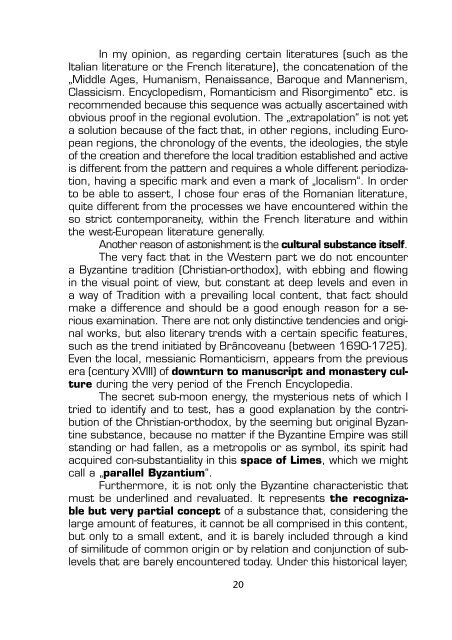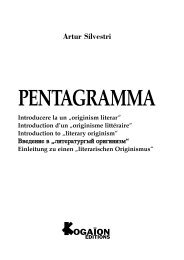genius loci pt. pdf.qxd - ROMANIAN LIBRARY
genius loci pt. pdf.qxd - ROMANIAN LIBRARY
genius loci pt. pdf.qxd - ROMANIAN LIBRARY
Create successful ePaper yourself
Turn your PDF publications into a flip-book with our unique Google optimized e-Paper software.
In my opinion, as regarding certain literatures (such as the<br />
Italian literature or the French literature), the concatenation of the<br />
„Middle Ages, Humanism, Renaissance, Baroque and Mannerism,<br />
Classicism. Encyclopedism, Romanticism and Risorgimento“ etc. is<br />
recommended because this sequence was actually ascertained with<br />
obvious proof in the regional evolution. The „extrapolation“ is not yet<br />
a solution because of the fact that, in other regions, including European<br />
regions, the chronology of the events, the ideologies, the style<br />
of the creation and therefore the local tradition established and active<br />
is different from the pattern and requires a whole different periodization,<br />
having a specific mark and even a mark of „localism“. In order<br />
to be able to assert, I chose four eras of the Romanian literature,<br />
quite different from the processes we have encountered within the<br />
so strict contemporaneity, within the French literature and within<br />
the west-European literature generally.<br />
Another reason of astonishment is the cultural substance itself.<br />
The very fact that in the Western part we do not encounter<br />
a Byzantine tradition (Christian-orthodox), with ebbing and flowing<br />
in the visual point of view, but constant at deep levels and even in<br />
a way of Tradition with a prevailing local content, that fact should<br />
make a difference and should be a good enough reason for a serious<br />
examination. There are not only distinctive tendencies and original<br />
works, but also literary trends with a certain specific features,<br />
such as the trend initiated by Brâncoveanu (between 1690-1725).<br />
Even the local, messianic Romanticism, appears from the previous<br />
era (century XVIII) of downturn to manuscri<strong>pt</strong> and monastery culture<br />
during the very period of the French Encyclopedia.<br />
The secret sub-moon energy, the mysterious nets of which I<br />
tried to identify and to test, has a good explanation by the contribution<br />
of the Christian-orthodox, by the seeming but original Byzantine<br />
substance, because no matter if the Byzantine Empire was still<br />
standing or had fallen, as a metropolis or as symbol, its spirit had<br />
acquired con-substantiality in this space of Limes, which we might<br />
call a „parallel Byzantium“.<br />
Furthermore, it is not only the Byzantine characteristic that<br />
must be underlined and revaluated. It represents the recognizable<br />
but very partial conce<strong>pt</strong> of a substance that, considering the<br />
large amount of features, it cannot be all comprised in this content,<br />
but only to a small extent, and it is barely included through a kind<br />
of similitude of common origin or by relation and conjunction of sublevels<br />
that are barely encountered today. Under this historical layer,<br />
20



